
For over 30 years Carol has looked after the garden which is loved not only by herself but her family too and she knows every part of the soil and the plants.
She loves spending time in the garden and enjoying the peace of the surrounding countryside.
Every season brings delight, challenges and problems 'but that's the thing about gardening, it's ever-changing and its's always exhilarating.
Over the 6 episodes Carol is going to show a whole year in the garden 'how it grows, flourishes, dies and is reborn.
She loves spending time in the garden and enjoying the peace of the surrounding countryside.
Every season brings delight, challenges and problems 'but that's the thing about gardening, it's ever-changing and its's always exhilarating.
Over the 6 episodes Carol is going to show a whole year in the garden 'how it grows, flourishes, dies and is reborn.
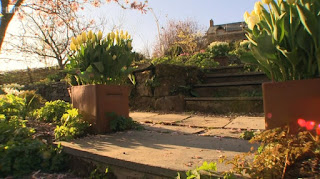
Spring
This episode follows the huge transition the garden makes when it goes from Winter into Spring.
During March and April, huge changes take place and the remnants of the winter with cold dank days hangs about until the middle of Spring.
After the apprehension of Winter the 'feelings of hope' all happen within weeks of Spring starting.
It is a very busy time in the garden with the last of the debris to clear leaving room for planting for plants yet to come.
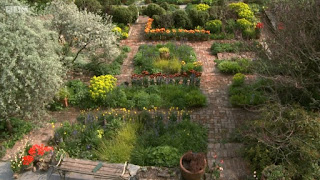
There is never enough time and pruning must be done by the end of March and the most exciting thing is sowing the first seeds of the year.
Early March

Carol is in her potting shed and Carol says her year does not start in January as her gardening year starts when she sows her first seeds of the year.
She finds these first seeds the most exciting and its a 'leap of faith' planting the seeds that will hopefully turn into a plant.
The first seeds she is planting are Nicotiana Langsdorffii Tobacco Plant, that is green with blue Anthers and in just a pinch of seeds there are enough for a 100 plants.

Sometimes when you have a lot of seeds like Poppy seeds you bung them all in, 'don't do it' says Carol as if they are too close together they are prone to dampening off and wont grow.
Carol's cat arrives to help or hinder!
She always finishes her planting trays off with some grit over the top to retain the moisture, prevent weed seedlings growing that may fly in!
You should always use shop bought compost as home made will contain weed seeds and possibly pathogens.
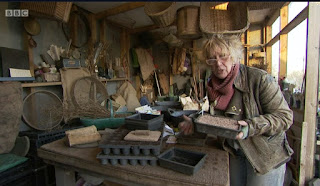
Next job is to label the seed tray after flattening it down, she then stands the whole tray in water for it to soak in to the compost.
Next she is sowing a bigger seed some Cerinthe seeds by 'station sowing', which is sowing 1 seed at a time and she puts each in their own section of the seed tray.
One week the garden can be bare and the next week everything bursts into life and in a few weeks everywhere is green and alive.

All the plants Carol had taken out of the border have been divided and replanted and now they just need some love.
Nature 'always has the last word' and sometimes that nurture is not enough to save a plant and with the harsh winter Carol beloved Astelia has been killed.
Husband Neil helped out with the heavy lifting as it had grown very big but she is using the terrible tragedy to plant a new tree in its place a gorgeous Amelanchier Snowy Mespilus.
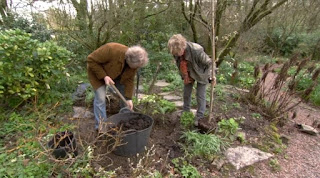
The soil where the Astelia was has lots of clay so Neil goes to get some compost and the Amelanchier they are planting is called La Paloma The Dove.
It has been grafted on to a root stock so it needs to be planted dead level so none of the graft is under the ground.

A few weeks ago there were Snowdrops everywhere but now they have been replaced by Pulsatilla, the purple of the violet that have self seeded everywhere.
It is still just sparkles of colour before the main show of the kaleidoscope of bright colours start.
Mid March

Typical March weather of sunshine and rain and Carol is in the Brick Garden and she startes to tidy up the debris from last season.
Now the weather is alright she is also dividing plants and has her tarpaulin at the ready to lay them on.
She starts by digging up a Helenium that is already in 3 clumps and they are very easy to divide as they separate themselves.
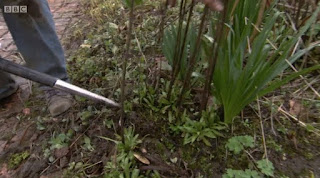
Carol uses the old stems as levers to prise them apart and she is left with a perfect little plant.
You can give the roots a wash in a bucket but you can usually see the good root system it already has.
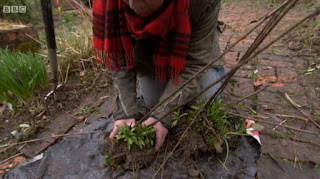
She will replant them straight away in a clump of 5 - 7 plants and whatever shape she wants for the spot she has chosen.
To watch the plant then grow on, is a wonderful thing, knowing you have nurtured it, to let it grow.
A Devonshire Lane
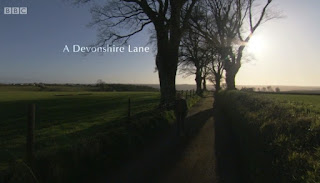
Carol is off with her dog for a walk down a lane and says that when someone asks her what her favourite flower is and although difficult hers has to be, the Primrose.
It is a typical Devon flower and it is so simple and perfect and she loves everything about it from the pale flowers to the little pink stems and egg yolk coloured centre.
She started off with just 1 plant bought from a wildflower nursery in her own garden they are now all over the place.
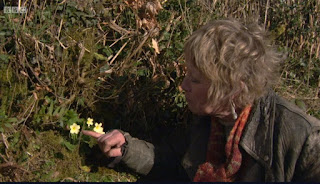
She now has many generations of Primroses and the process starts when the flower fades and the seed pod expands like a little bright green spear.
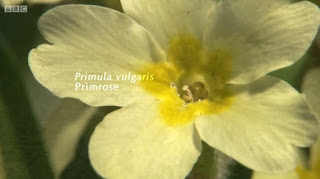
The seeds are also bright green and it is already fertile and ready to be sown by taking off the seed head and popping it open and then wipe the sticky seeds onto some compost.
Within weeks they will germinate and then grown on to flower the following year.
End of March

Carol is back in her potting shed in the dark and says its not possible to get everything done during the daylight hours.
She does not mind as she is dealing with her most treasured plants her huge Eucomis bulbs and this one is called Sparkling Burgundy as its got deep purple leaves.

She always keeps hers in pots but they can be grown outside but she treats them very well as they are precious to her so they get pampered.
She is moving this one to a bigger pot with new, rich compost so it will grow even more bigger and be more bountiful.
Afterwards they are returned to the greenhouse and they come out when they start to shoot.

She finishes off the potting with some grit on top.
Carol in the greenhouse, venting it and watering the plants and the garlic planted in the winter is ready to be transplanted.
They are having major work done to the cottage and Neil is up the scaffold to to paint the barn owl box.
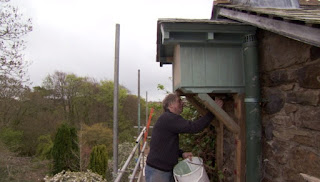
Neil says they used to have a pair of barn owls about 30 years ago so he is trying to encourage them back with a new box he has built that he is now painting.
Carol has just found a bird fluttering round the kitchen she has caught to release outside.
April

It is Tulip time and Carol like most gardeners cannot resist growing them.
She has not got the right type of soil but this doesn't stop her putting on an amazing display.
They need a light alkaline, free draining soil that is baked by the hot sun.
Carol has clay soil that is slightly acidic so she grows all her Tulips in pots this also means she can move them to the best position.
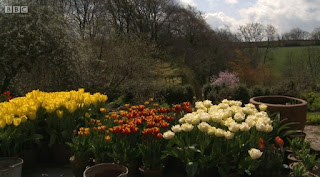
They need a period of cold so they start off on the top terrace and when they flower she carries them to different parts of the garden.
Although they look best at their peak she also like them as they start to fade and you can see the Stigma inside.
'Each plant has its time'.
Cloud Pruning
In the hot border the hedge has been bothering Carol so she has called in Jake Hobson to cloud prune the hedge and make it special.
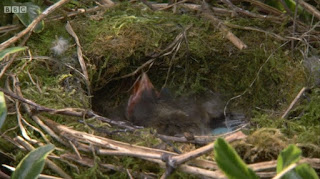
Carol first shows us a Dunnock nest in some of the hedge, there are several eggs but 1 chick has hatched with its big orange beak so they will be leaving that part of the hedge.
Cloud pruning is an real craft and Jake has studied all the different pruning styles from around the world.
Carol shows him the hedge and he says its very healthy and dense and Carol wants the style to fit in with the rest of her hedging.

Jake says it will look organic with a little bit of definition to it.
He has brought some photos to show Carol of different styles he has done.
He starts with a pair of secateurs and takes out some of the woody growth and takes it off bits with side foliage.

Box can be shaped just as well as Yew as it also has small foliage which is what you need.
This should be pruned in the Spring or Autumn.
Carol has borrowed the sharp secateurs to do a little job in the garden to a Cotoneaster Horizontalis that is hanging all over the side of the wall.

It is an evergreen and it has spread too far and needs cutting back as it is invading a Pulsatilla.
It is a Alpine that is in the perfect situation and the flowers start off upright then droop over when its pollinated then the stem becomes erect as the silky seed heads turn to fluff.

On a windy day the parachute take the seeds away all over the garden.
Jake has done a brilliant job and it is echoing the clouds this will now need clipping once a year in the Autumn when access is easier.
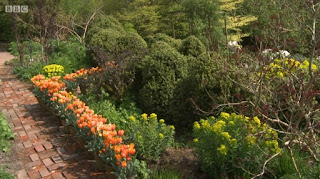
He has left the final bit for Carol to clip and the hedge is complete.
Magnolias
April is the time for the trees to start to come out and her favourite trees are her 2 Magnolias.
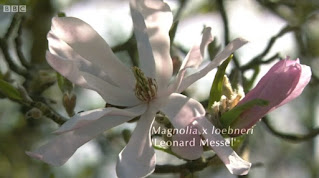
One is a Magnolia Leonard Messel with deep lilac buds turning into paler water lily type flowers.
The other one nearer the house is Magnolia Stellata which is a large tree and gets smothered in flowers and they have been around for 100 million years.

They actually existed before bees so produce no nectar and are pollinated by beetles leaving bees very disappointed!
Another plant at its best in April are Dark Trilliums Chloropetalum although it is a long flowering plant it actually takes 7 years from seed to flowering.
Carol outside in the Spring warmth potting on some Cerinthe that she sowed a few weeks ago.
Her Nicotiana Langsdorffii are also ready to move on to bigger seed trays as they have their first true leaves. Carol uses a chopstick to prick them out.
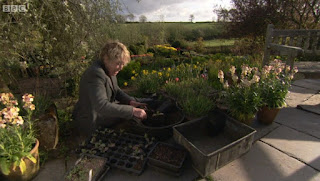
Carol says you cant believe the terrible weather they had and at the beginning of Spring everything was still so bare.
You start to think nothing will grow but now look at how the garden has burst into life.
All Photos copyright of BBC.com

No comments:
Post a Comment